The Apple iPhone 6s and iPhone 6s Plus Review
by Ryan Smith & Joshua Ho on November 2, 2015 8:00 AM EST- Posted in
- Smartphones
- Apple
- Mobile
- SoCs
- iPhone 6s
- iPhone 6s Plus
System Performance Cont'd
Moving on towards our more GPU-bound workloads, we use our standard test suite of benchmarks like GFXBench and 3DMark to get a good idea for performance. Unfortunately, due to the move to iOS 9 the Unity engine version used in Basemark X is no longer working so for now we’re left with 3DMark and GFXBench. There is also Basemark OS II’s graphics test, but this is embedded in a larger benchmark with CPU and storage performance tests.

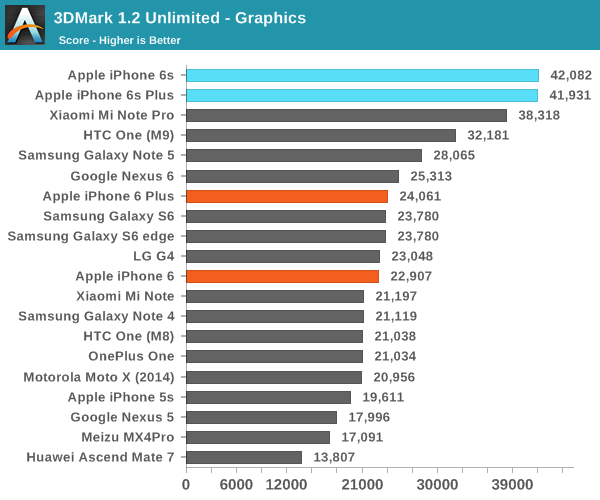
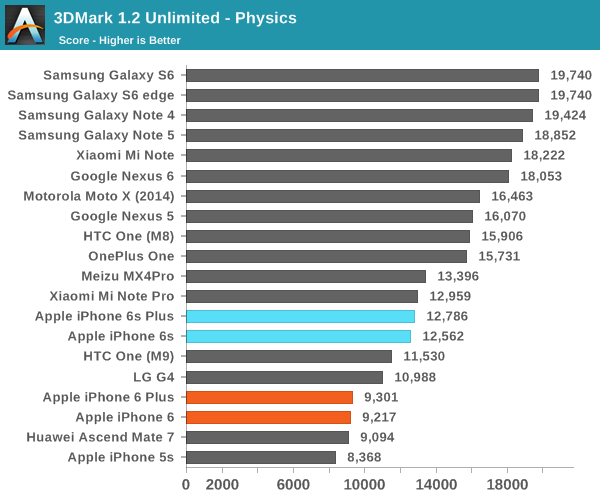
As always with 3DMark, there are some issues in the data structures used. Due to the data dependencies present within the physics test, it is necessary for the CPU to stall for data to be committed to memory before continuing on to the next portion of the test instead of executing instructions in parallel. This strongly reduces the practical performance of the CPU because the architecture is primarily focused upon instruction-level parallelism to deliver major performance gains. However, due to the strong showing in graphics performance the iPhone 6s’ still manage to take the lead.
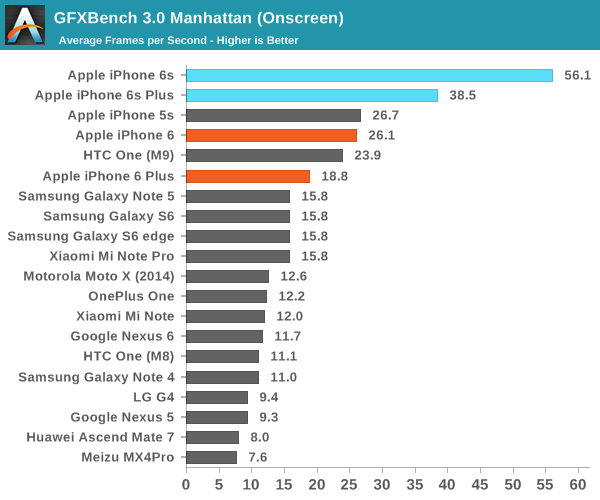
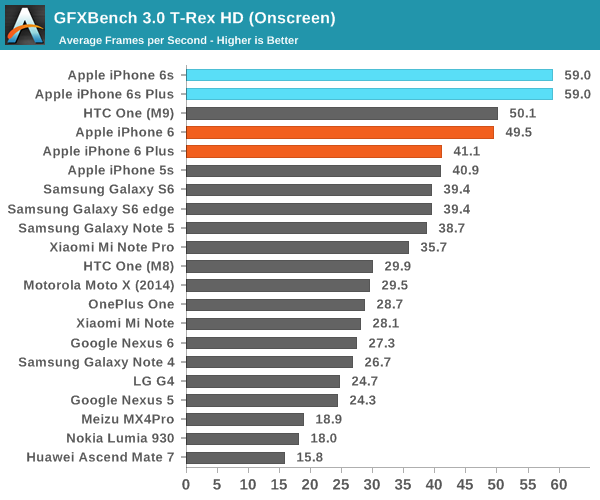
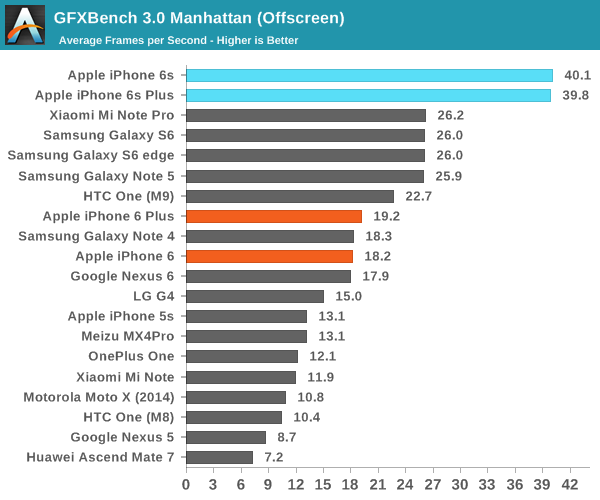

In GFXBench, the A9 SoC just shows absurd performance. It’s strange to think about how the iPad Air 2’s GPU seemed incredibly quick at the time but with the A9 Apple has surpassed that level of performance in their smartphone SoCs. The move to a new generation of PowerVR GPU IP, in addition to the move to a FinFET process node are really the drivers for this kind of performance improvement.
Overall, the Apple A9 SoC is the best SoC in any phone shipping today. In cases like web browsing, gaming, and even just going through the UI it’s quite evident that this new SoC is a major factor in improving performance and smoothness across the board. Something as simple as visiting some popular tech websites will show this, which really goes to show how much “specs” still matter due to their influence on user experience.
NAND Performance
At this point is almost goes without saying that storage performance is important, but in a lot of ways the testing here is still in its early days. In the case of the iPhone 6s we’ve discussed what distinguishes its storage solution from others in this industry, but for those that are unaware the iPhone 6s uses PCIe and NVMe instead of a UFS or eMMC storage solution. In a lot of ways, this makes the storage on board closer to the SSD that you might find in a more expensive PC but due to PCB limitations you won’t necessarily see the enormous parallelism that you might expect from a true SSD. In the time since the initial results we've found that all of our review units use Hynix-supplied NAND. In order to test how this storage solution performs, we use Eric Patno’s storage test which allows for a simple storage test comparable to AndroBench 3.6.
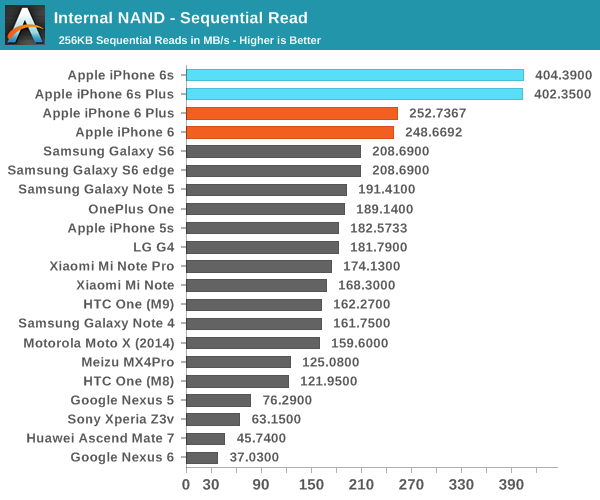
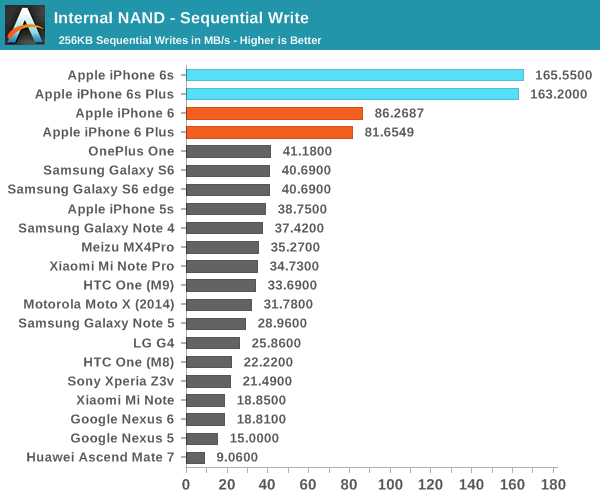
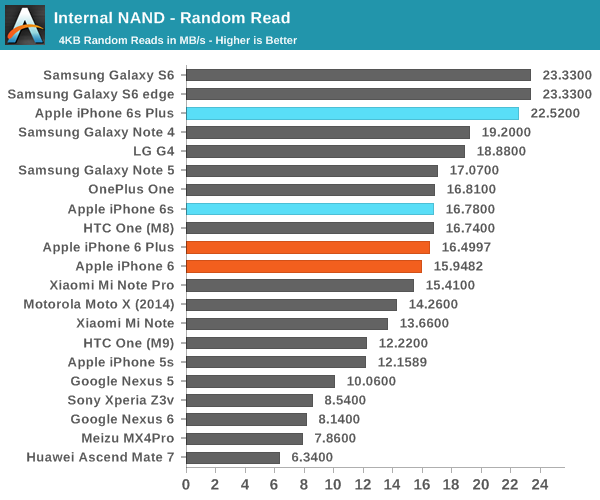
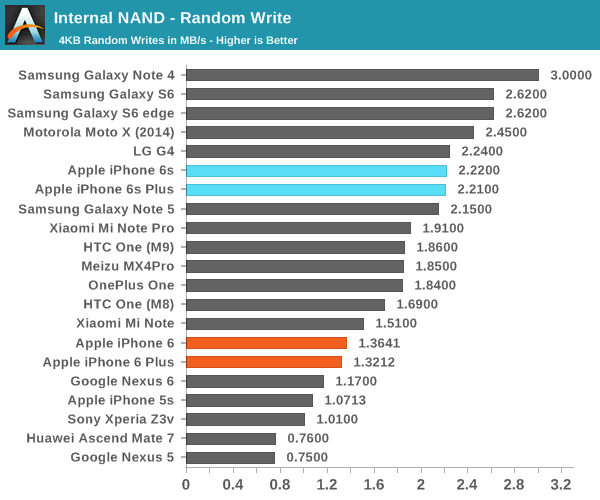
Here, we can really see the enormous performance improvements that result from a combination of TLC NAND with an SLC cache, along with the new NVMe protocol which allows for low CPU overhead and removes architectural bottlenecks to storage performance. This should allow for things like faster burst photos and faster app updates. Downloading and updating apps on the iPhone 6s feels noticeably faster than it is on the iPhone 6, to the extent that small apps feel like they install almost instantly when I’m on a WiFi connection fast enough to saturate storage bandwidth.










531 Comments
View All Comments
HotdogPercolator - Monday, November 2, 2015 - link
All of your "needs" are mine as well and I do them on a Jailbroken iPhone. I'm sorry if you're not smart enough to look past obstacles, but everything Androids do the iPhone can do just as well. Stop holding yourself back from a great experience. Branch out!BabelHuber - Monday, November 2, 2015 - link
How did you install rSAP-drivers on your iPhone? How did you unlock the bootloader? Can you install a different OS?Where do you put SD-cards in?
JLiRD808 - Monday, November 2, 2015 - link
Wow...we're sorry if you think your jailbroken iphone can do what a rooted android can do. While you have access to some apps that allow some customization, Android has that AND allows the OS to be completely tweaked and even swapped out! And Google encourages it!Can you even customize your CPU speed? Oh wait! You can speed up your animations so it LOOKS LIKE your CPU is operating faster lol. Nice one :P
Not that it matters, 90% of iphone 6s buyers are doing the same thing they were doing on their iphone 4/5.....Instagram, Facebook, the occasional game or two. Things'll be a few milliseconds snappier, sure. They'll only use "Live Photos" once or twice since it takes up extra storage. I give Apple credit for getting average users to drop big dollars on premium devices--they're truly amazing sheep-herders, and getting richer by the minute.
zeeBomb - Tuesday, November 3, 2015 - link
Uh but you can change how it performs tho...blackcrayon - Wednesday, November 4, 2015 - link
"Can you even customize your CPU speed?"LOL, so you can go from "slower than the best", to "even slower" to make up for the heat, battery life, and nosediving-performance-over-time compromises at the stock speed? Sounds really enviable!
tuxRoller - Friday, November 6, 2015 - link
That doesn't take processor variation into account.If you can stably undervolt your processor, you only gain battery life. Likewise, if you can overclock it and keep the voltages in check you see battery gains from race to idle
mikhapop - Monday, December 14, 2015 - link
yeah, a lot of us are tired of arguing apple fans, the iphone can't stand my needs (advanced or not).1- Install iTunes to connect my phone to pc
2- Very low RAM (stupid tabs refreshing)
3- Very low resolution screen
4- No stylus for taking notes (i have a note 4)
5- Can't tweak the system (playing with kernels to get better battery life or performance when needed)
6- Can't run advanced systems that i need them (a web development & linux specific systems)
the only thing i like about the latest iphones is the style (i like the way these phones look) but i think also the s6 edge is equally as good looking if not better.
JLiRD808 - Monday, November 2, 2015 - link
I think we're at "6 +" now supporting you lolblackcrayon - Monday, November 2, 2015 - link
Congratulations for encapsulating your total lack of knowledge of technology in such a clear, concise paragraph. Extra "expert" points for "the RAM is very little"...Macman2288 - Monday, November 2, 2015 - link
"SoC benchmarks are all synthetic and dubious" - so how would you test performance? This site is a benchmark site, that is what they do. If you hate benchmarks maybe this site is not for you."camera resolution s fully ignored, motion blur (the biggest problem for users) has never been tested" - you must not have read the article, motion blurr, image resolution, and video quality were all explored and displayed fairly for the reader to see.
"LTE is just cat 6" - 8-/ i have no words
"And lets not forget signal strength , god forbid you would ever mention how terrible iPhones are there" - are you talking about the iPhone 4? iPhones have the same chips and antenna designs as most other smart phones and appear to perform as well as more android phones.
"15 years ago you would laugh at people like you, irrational and lazy as you got." - You just described yourself today.
Yes my name says it all, I do enjoy apple products, but if was going to bash an article I would try to be a little more convincing. I have seen way better arguments for not buying an iPhone then what you displayed.